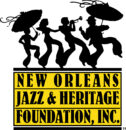A Labor of Love, and a Monumental Resource
A major milestone in the documentation of Cajun and Creole music
Published: August 31, 2021
Last Updated: December 1, 2021

Photo by Michael P. Smith, The Historic New Orleans Collection
Ann Savoy performs with husband Marc Savoy.
Despite this chronological gap, the two books fit together seamlessly, unified by both the distinctive graphic design template that Savoy created for them, and through their deeply detailed, wide-lens examination of Cajun and Creole music, which totals almost nine hundred pages. The books draw on numerous interviews, ranging from 1970s conversations with musicians now long gone, to a more recent talk with the zydeco accordionist Nathan Williams, who remains vibrantly active at this writing. Many interviews were conducted in Cajun or Creole French, in which Savoy is fluent, and all of them were transcribed, phonetically transliterated, and translated into English—and then, recently, digitally archived by Mollie Farr and Savoy’s son Joel as The Ann Savoy Collection, for the Arhoolie Foundation. (Since the early 1960s, the California-based Arhoolie Records has made invaluable contributions to documenting a wide range of traditional music in Louisiana, and elsewhere.)
The books’ primary focus is on musicians from decades past—many of whom, while brilliantly talented, were never famous, and are barely known today. Such esoteric status may appeal most to music scholars, who will find Savoy’s books a profoundly rich source for in-depth research. Academic significance aside, however, many of the interviews stand on their own intrinsic merits as eloquent gems of oral history, and as important snapshots in time. The ballad singer Sullivan Aguillard, for example, recalled, “In the wintertime when we were small . . . [sitting] by the fire . . . one [of my family elders] would tell the other, ‘Why don’t we sing so and so?’ And those two people would sing to where my sister and I would go crying. That’s the truth. That’s how beautifully they could sing.” In a similar vein, the ballad singer and fiddler Edius Naquin, who grew up in dire rural poverty, wistfully observed nonetheless that “people made a happier life then than now. Now everyone goes too quickly.” This observation ties in with Savoy’s intent for these books “to share the unique world that drew me to Louisiana, to give outsiders a look at the people of the pre-TV generation, who mainly spoke French, and who typically couldn’t write about themselves.”
The books’ primary focus is on musicians from decades past—many of whom, while brilliantly talented, were never famous, and are barely known today.
Some interviews chronicled pivotal moments in the evolution of Cajun music. During the ’30s, for instance—when electronic amplification was introduced to South Louisiana—fiddles, guitars, and the like could be heard clearly for the first time. As a result, the accordion—which was naturally loud, sans amplification—went out of vogue, temporarily, during what has been retroactively dubbed “the Cajun string band era.”
“We were trying to get that old swamp organ out of the way,” the Cajun-swing steel guitarist Julius “Papa Cairo” Lamperez disdainfully commented to Savoy. The accordion did return to prominence in the late ’40s, but in properly proportionate volume with the other instruments.
The lyrics to over two hundred songs are recorded and musically transcribed, too, by Savoy and various friends in Volume I, and by Daniel Coolik and Danny Devillier in Volume II. Such attentive focus fits with Savoy’s mission of making Cajun and Creole music accessible to beginners and neophytes. Informal tutorials include discussions of a capella ballads and the instruments on which Cajun and Creole music are played, encompassing the history of their evolution, and the basics of correct technique—for playing fiddle, guitar, steel guitar, harmonica, percussion and drums, and accordion. The latter instrument is also discussed in a well-written chapter by Savoy’s husband, Marc, a master accordionist and accordion builder, whose own book, Made in Louisiana, is forthcoming from University of Louisiana at Lafayette Press.
Volume I garnered Savoy a prestigious Benjamin A. Botkin Prize from the American Folklore Society, and a rave review in the Washington Post as “perhaps the most comprehensive and stunning portrait of this music ever written.” Early reviews of Volume II have been equally enthusiastic. Savoy’s intense focus on French Louisiana is also expressed through her leading role in two groups, the Savoy Family Band and the foursome known as the Magnolia Sisters, as well as her album of lullabies, Fais Do Do (Valcour Records), with the Magnolia Sisters’ Jane Vidrine. But Savoy’s eclectic interests extend far beyond Cajun music—to her classic old-time jazz and swing band, the Sleepless Knights; to Adieu False Heart (Vanguard Records), the album that she recorded with Linda Ronstadt, under the name the Zozo Sisters; and to an upcoming album that will include her renditions of songs by the diverse likes of Bruce Springsteen, The Kinks, and the ’70s British folk-rock band Fairport Convention, and an original COVID complaint, entitled “No Sequins Tonight,” co-written with her daughter Gabrielle. (In addition to Gabrielle and Joel, Savoy’s two other children, Sarah and Wilson, are also actively involved in her musical projects.)
“Many people have come before or alongside me,” Savoy reflected in a recent interview, “researching these old songs. People such as Irène Thérèse Whitfield, Catherine Blanchet, Harry Oster, Joshua Clegg Caffery, and Barry Jean Ancelet. I really hope that new enthusiasts will appear and continue this work.” And when such new enthusiasts do come along, Savoy’s books will serve them as an indispensable resource.
Ben Sandmel is a New Orleans–based writer, folklorist, producer, and the former drummer for the Grammy-nominated Cajun/Western swing band The Hackberry Ramblers. In May 2018, the LEH honored Sandmel with an award for his Lifetime Contributions to the Humanities. In January 2020 the Folk Alliance International honored Sandmel with a Spirit of Folk Award.
Sound Advice is funded in part by a grant from the New Orleans Jazz & Heritage Foundation.

